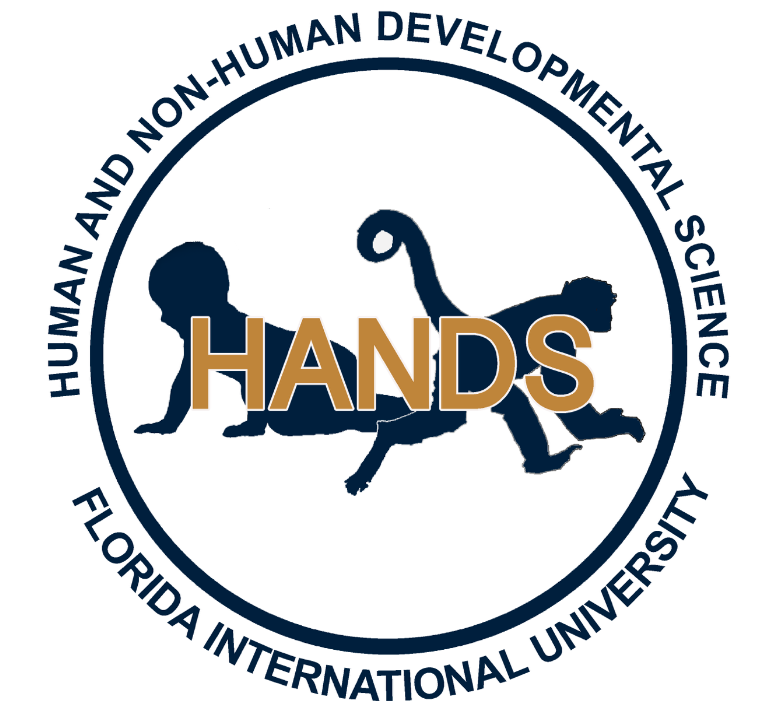Click on the buttons inside the tabbed menu for details about our current projects.
Infant motor trajectories and language outcomes
The goal of this research is to examine early bimanual motor skill as a novel predictor for language development. Motor experience provides rich opportunities for learning in infants. Fine motor skills shift from initial success reaching and grasping an object to more complex exploration where one hand holds the object for the other hand's manipulation (role-differentiated bimanual manipulation, or RDBM). A consequence of new motor skills like RDBM is a dramatic change in how infants engage in their world, and infants and toddlers who demonstrate proficiency in a motor skill are more likely to exhibit advanced language skills. This project will characterize developmental trajectories for RDBM skill, and use these trajectories to predict preschool language outcomes. Examining motor-language trajectories has important implications for developing benchmarks for typically developing children as well as children with or at risk for developmental delays and disorders.
Funding:
- NIH/NICHD grant R03HD097419 (PI: Nelson // 2019-2022 // $146,500 total costs)
- FIU Center for Children and Families Intramural Award (PI: Nelson // 2016-2017 // $5,000 total costs)
Collaborators:
Related publications:
Fine motor skills and school readiness in pre-kindergarteners
The goal of this research is to assess the links between fine motor skills and school readiness in children preparing to enter kindergarten who have behavioral, emotional, or learning problems. In this project, two aspects of fine motor skill are evaluated – writing and manipulation – within the context of a comprehensive 7-week summer treatment program (
STP-PreK) administered by clinical faculty and trained staff. Prior research has shown that both of these skills measured at preschool age are predictive of later reading and math achievement, highlighting the potential utility of fine motor performance as a marker for future school readiness. This project will examine whether participation in STP-Pre-K improves fine motor skills in at-risk children. Results may help to refine early intervention efforts as well as promote long term academic success.
Funding:
- STP-Pre-K is funded by a generous grant from The Children's Trust (PI: P. Graziano; Co-PI: K. Hart // 2016-2022 // $516,264 total costs).
Collaborators:
Related posters:
Preschool hand use and social-emotional skills
The goal of this research is to measure how children between 3- and 5-years-old use their hands during an early childhood education program designed to develop and improve social-emotional learning skills (
Illinois Art Station Itsy Studio). Children receive weekly visual arts lessons over a 12-week period from professional art educators and Illinois State University graduate and undergraduate students. Data collection is focused on measuring hand preference and fine motor skill during the art lessons, along with quantifying teacher-child and child-child interactions in the classroom. Analyses will examine whether participation in the art program enhances the development of manual and social-emotional skills, and explore motor-social links during the preschool period. Results may aid in preparing children to be successful in school.
Funding:
- Illinois Art Station's Itsy Studio is funded by a generous grant from PNC Grow Up Great (PI: M.K. Bersett // 2019 - 2021 // $45,000 total costs).
Collaborators:
Fine motor skill in spider monkeys
The goal of this research is to characterize how spider monkeys use their hands for grasping objects. The spider monkey is an important model for studying manual skill – unlike most other primates, spider monkeys do not have a thumb. In our prior work, we have shown that hand use patterns in spider monkeys vary by task, and that increasing task difficulty increases hand preference strength. Moreover, we have shown that spider monkeys can isolate a single digit, overturning the long-held claim that the spider monkey hand operates like a hook. We are currently using motion tracking to examine how spider monkeys perform on a reach-to-grasp task requiring fine motor skill. Results will advance our understanding of the evolution of reaching and grasping in primates.
Related publications:
